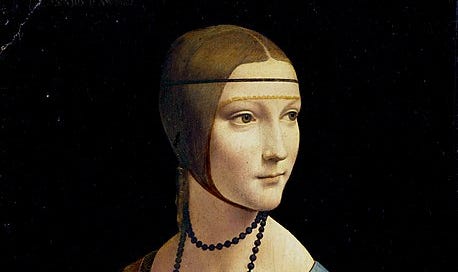Note: read part III.
"I have been impressed with the urgency of doing. Knowing is not enough; we must apply. Being willing is not enough; we must do." - Leonardo da Vinci, 1490
Leonardo walked the 160 miles to Milan in 1482, arriving in a city of over 100,000 people that was different in character and culture from Florence. The air felt colder in his new home. Not just from the northern wind that rolled in off the plains but also in how people carried themselves. Florence had been full of philosophy, of beauty, of books, of what it meant to be good. In Milan, people looked for outcomes more than ideals.
But these differences didn’t bother Leonardo. He had his goals in mind, and that's where he placed his focus. Especially given the uphill climb of being new in town. Unlike in Florence, he had no fanfare. Just his ideas and a letter in hand to Ludovico Sforza, in which he wrote (note: translated and modernized),
"Most Illustrious Lord,
Having now sufficiently considered the specimens of all those who count themselves skilled in the art of inventing instruments of war, and that the invention and operation of the said instruments are nothing different from those in common use, I shall endeavor, without prejudice to anyone else, to explain myself to your Excellency, showing your Lordship my secrets, and then offering them at your pleasure.
I have plans for bridges, very light and strong, and easy to carry, for use in pursuit or retreat, others to resist fire and destruction, easy to place and remove. I also have methods for burning and destroying those of the enemy.
I know how to remove water from moats and make an infinite variety of scaling ladders and other instruments for siege warfare.
If the place cannot be reduced by bombardment, I have means to destroy any fortress or redoubt, even if it is founded upon solid rock.
I have types of mortars; most convenient and easy to carry; and with these I can hurl small stones almost like a storm, causing great terror to the enemy.
I have means, by secret and tortuous mines and winding passages, to reach a designated point, even if it means going under a river.
I can make covered wagons, safe and unassailable, which will penetrate the enemy and their artillery, and there is no company of soldiers so great that these cannot break through them.
I can make bombs, catapults, and other machines of marvelous efficiency.
When it is necessary to fight at sea, I know how to make many engines most efficient for attack and defense; ships that withstand cannon fire, and others that will resist fire and smoke.
In time of peace, I believe I can give perfect satisfaction and equal success in architecture: designing buildings public and private, and conducting water from one place to another.
I can also execute sculpture in marble, bronze or clay, and in painting I can do as well as anyone else, whoever they may be.
Moreover, I would be glad to show Your Excellency at your pleasure any of the things described above, and to demonstrate them in action.
Your Excellency's Most Obedient Servant,
Leonardo da Vinci"
What stands out is where painting falls in the letter. Nearly at the end. Much of the letter before focuses on weaponry. Leonardo likely understood the world he was stepping into now. Milan wasn’t looking for beauty. Milan was preparing for war.
Keep reading with a 7-day free trial
Subscribe to Historical Snapshots to keep reading this post and get 7 days of free access to the full post archives.



